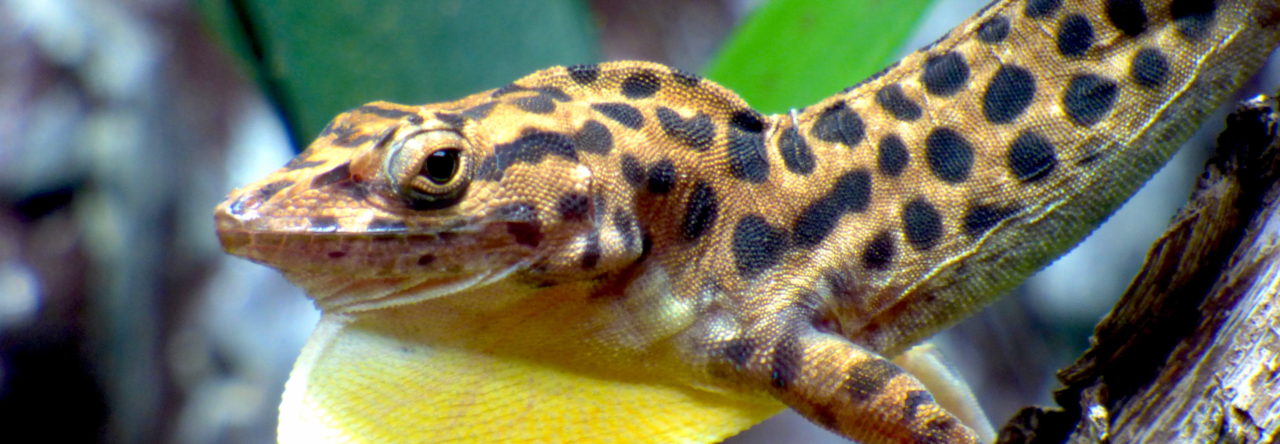
Aggressive encounter between anoles. Both opponents are watching each other with their right eyes. Photo: Johnson Lab, Trinity University
Have you ever gotten an angry look from an anole? Has he ever displayed at you, demanding that you get out of his territory? If so, chances are that if an anole was giving you the stink eye, he with using his left side! I’m blogging live from the Society for Integrative and Comparative Biology (SICB) meeting in San Francisco. My first stop has been to view Michael Patton’s poster examining the neuroanatomy of aggressive behavior. Patton is a senior undergraduate student at Trinity University working with Dr. Michele Johnson. Early birds at SICB have the opportunity to put their posters up for early viewing, so I got a sneak peek of his work last night although he’s not slated to present until Saturday.
For his project, Michael addressed the question of brain lateralization in aggressive displays. Some evidence suggests that anoles tend to favor their left side during competitive encounters. Patton and colleagues built on these studies by examining behavioral laterality in the field and neuroanatomy in the lab in the same individuals. Through observations of wild A. carolinensis, Patton found support for this idea – the winning male tended to view his opponent from his left side!
We know that visual signals in Anolis cross the optic chiasm in the brain, and project to the contralateral visual cortex. Additionally, there appears to be little integration between hemispheres for neural input. This means that the right side of the brain should know what the left eye has seen, but not what the right eye sees. In light of this, Patton’s follow-up question was – is there lateralization in brain structures, as well? To this end, he examined soma size and density in the preoptic area (POA), which is the first stop for visual signals in the brain, and the amygdala, one of the brain centers associated with aggression. He found a greater soma size for neurons on the right side of the POA, but no differences in size in the amygdala. Cell density did not differ between right and left sides in either brain region. This result makes sense – if lizards are favoring their left eye for contests, then the right POA should be receiving more signals, and soma size should be larger. However, this increase in visual input is not translating into greater cell size in the amygdala or cell density in a major brain center for aggressive behavior. Any thoughts on why this might be occurring? Right or left-brained ideas are both welcome, of course.
- SICB 2018: Revisiting the Fitch-Hillis Hypothesis in Mexican Anoles - January 8, 2018
- Evolution 2017: Urban Anoles Sprint Faster on Smooth Substrates - June 26, 2017
- SICB 2017: New Insights into Pre- and Postcopulatory Selection in Anoles - January 10, 2017


Philip M. Fortman
err. . . aren’t BOTH anole (in the photo provided) looking at each other with their right-side eye? In the commonly observed head-to-head aggression posture, both antagonists would confront with the same eye, either right or left. Is this dominance during the first display of aggression when both heads point in the same direction?
See: https://picasaweb.google.com/115769677707081451908/MaleAnolisSagreiFaceOff#5740318406229776274
and: https://picasaweb.google.com/115769677707081451908/AnolisFight10Days
Martha Munoz
I spoke with Michael today. He said he determined how much each male used their left vs. right side during a 30+ minute encounter to classify males as either left-dominant or right-dominant.
Martha Munoz
I will ask Michael about that, but here is the relevant caption from his poster: “Lizards that won a larger percentage of their trails were more likely to aggressively display from a left-eye orientation.”
Michele Johnson
Martha, thanks for this terrific summary of Michael’s work! Philip is right, that the anoles in the photo included here are both oriented such that they are viewing each other with their right eyes. In this photo (which is one of my favorites!) the lizards were in very close proximity, moments before locking jaws in a fight. My guess is, when you’re that close to violence, it doesn’t really matter what your lateral orientation is. But in Michael’s study, when we examined lizards in arenas that allowed the lizards to interact from a space of a few feet apart, we saw that the most aggressive (“winning”) male was more often orienting to interact with his competitor from the left side – but we did not see that pattern from the more subordinate (“losing”) males. In addition, we can conclude from this work is that most green anoles will interact from both their right and left sides – our finding of laterality is not an all-or-nothing kind of pattern, just like being a right-handed human doesn’t mean you never use your left hand.
Richard Tokarz
In response to Michele Johnson’s guess that when lizards are in very close proximity, moments before locking jaws in a fight, that it doesn’t really matter what your lateral orientation is when you’re so close to violence, it appears to me that A. Wallace Deckel came to the opposite conclusion based on the results of his study of laterality of aggressive response in anoles. In Deckel (1995), it is suggested that the use of the left eye is most common when males are in close proximity and this is especially the case when a male is threatening to bite (mouth open) or is biting its opponent. Any comments?